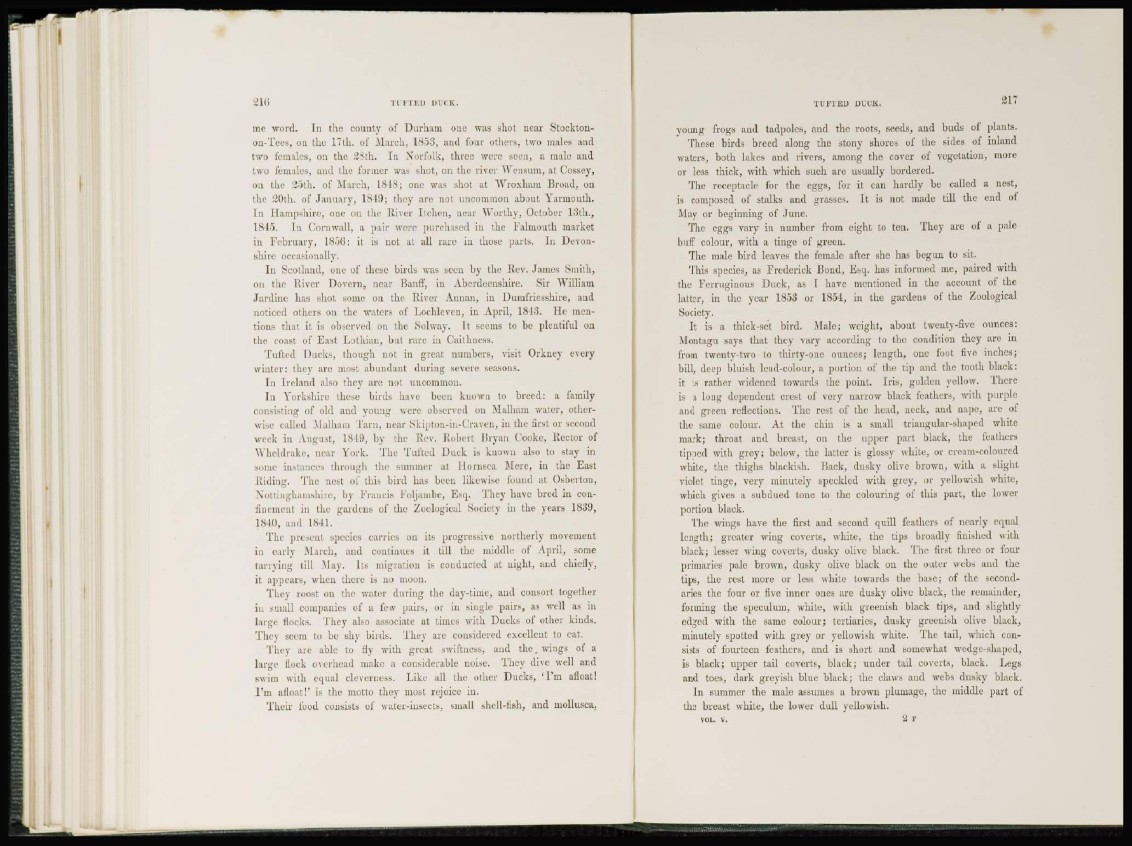
me word. In the county of Durham one was shot near Stocktonon
Tees, on the 17th. of March, 18-53, and four others, two males and
two females, on the 2Sth. In Norfolk, three were seen, a male and
two females, and the former was shot, on the river Wensum, at Cossey,
on the 25th. of March, 1818; one was shot at "VVroxham Broad, on
the 20th. of January, 1849; they are not uncommon about Yarmouth.
In Hampshire, one on the Rivet Itchen, near Worthy, October 13th.,
1845. In Cornwall, a pair were purchased in the Falmouth market
in February, 1850: it is not at aU rare in those parts. In Devonshire
occasionally.
I n Scotland, one of these birds was seen by the Rev. ,lames Smith,
on the Riven- Dovcrn, near Banff, in Aberdeenshire. Sir "William
Jardine has shot some OIL the River Annan, in Dumfriesshire, and
noticed others on the waters of Lochlevcn, in April, 1843. He mentions
that it is observed on the Sol way. It seems to be plentiful on
the coast of East Lothian, but rare in Caithness.
Tufted Ducks, though not in great numbers, visit Orkney every
winter: they are most abundant during severe seasons.
I n Ireland also they arc not uncommon.
In Yorkshire these birds have been known to breed: a family
consisting of old and young were observed on Malham water, otherwise
called Malham Tarn, near Skipton-in-('raven, in the first or second
week in August, 1849, by the Rev. Robert Bryan Cooke, Rector of
Wheldrake, near York. The Tufted Duck is known also to stay in
some instances through the BUMMER at Hornsea Merc, in the East
Riding. The nest of this bird has been likewise found at Osberton,
Nottinghamshire, by Francis Foljambe, Esq. They have bred in confinement
in the gardens of the Zoological Society in the years 1839,
1840, and 1841.
The present species carries on its progressive northerly movement
in early March, and continues it till the middle of April, some
tarrying till May. Its migration is conducted at night, and chiefly,
it appears, when there is no moon.
They roost on the water during the day-time, and consort together
in small companies of a few pairs, or in single pairs, as well as in
large t h i c k s . They also associate at times with Ducks of other kinds.
They seem to be shy birds. They are considered excellent to eat.
They are able to fly with great swiftness, and the, wings of a
large flock overhead make a considerable noise. They dive well and
swim with equal cleverness. Like all the other Ducks, ' I 'm afloat!
I 'm afloat!' is the motto they most rejoice in.
Their food consists of water-insects, small shell-fish, and mollusca.
young frogs and tadpoles, and the roots, seeds, and buds of plants.
These birds breed along the stony shores of the sides of inland
waters, both lakes and rivers, among the cover of vegetation, more
or less thick, with which such are usually bordered.
The receptacle for the eggs, for it can hardly be called a nest,
is composed of stalks and grasses. It is not made till the end of
May or beginning of June.
The eggs vary in number from eight to ten. They are of a pale
buff colour, with a tinge of green.
The male bird leaves the female after she has begun to sit.
This species, as Frederick Bond, Esq. has informed me, paired with
the Ferruginous Duck, as I have mentioned in the account of the
latter, in the year 1853 or 1854, in the gardens of the Zoological
Society.
I t is a thick-set bird. Male; weight, about twenty-five ounces:
Montagu says that they vary according to the condition they are in
from twenty-two to thirty-one ounces; length, one foot five inches;
bill, deep bluish lead-colour, a portion of the tip and the tooth black:
it is rather widened towards the point. Iris, golden yellow. There
is a long dependent crest of very narrow black feathers, with purple
and green reflections. The rest of the head, neck, and nape, are of
the same colour. At the chin is a small triangular-shaped white
mark; throat and breast, on the upper part black, the feathers
tipped with grey; below, the latter is glossy white, or cream-coloured
white, the thighs blackish. Rack, dusky olive brown, with a slight
violet tinge, very minutely speckled with grey, or yellowish white,
which gives a subdued tone to the colouring of this part, the lower
portion black.
The wings have the first and second quill feathers of nearly equal
length; greater wing coverts, white, the tips broadly finished with
black; lesser wing coverts, dusky olive black. The first three or four
primaries pale brown, dusky olive black on the outer webs and the
tips, the rest more or less white towards the base; of the secondaries
the four or five inner ones are dusky olive black, the remainder,
forming the speculum, white, with greenish black tips, and slightly
edged with the same colour; tcrtiarics, dusky greenish olive black,
minutely spotted with grey or yellowish white. The tail, which consists
of fourteen feathers, and is short and somewhat wedge-shaped,
is black; upper tail coverts, black; under tail coverts, black. Legs
and toes, dark greyish blue black; the claws and webs dusky black.
In summer the male assumes a brown plumage, the middle part of
the breast white, the lower didl yeUowish.
VOL. v. 2 t